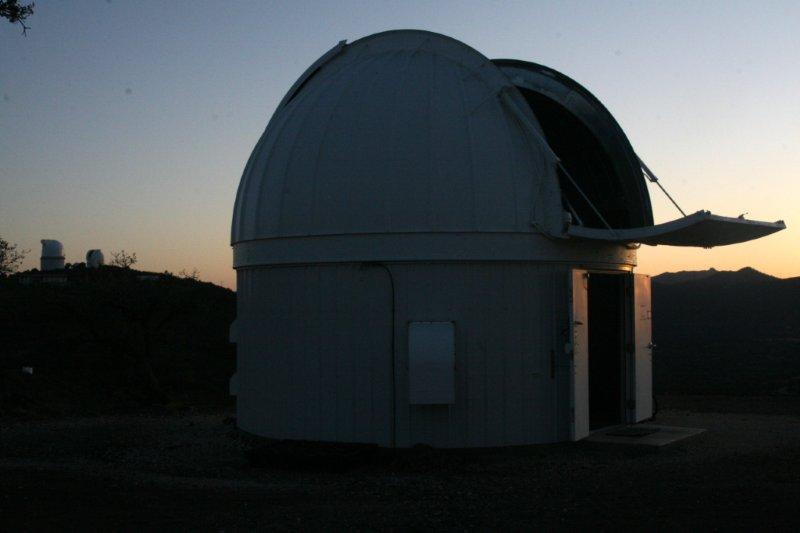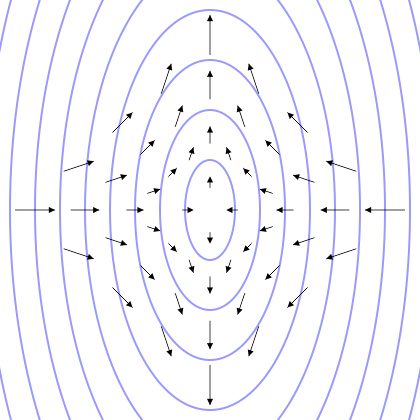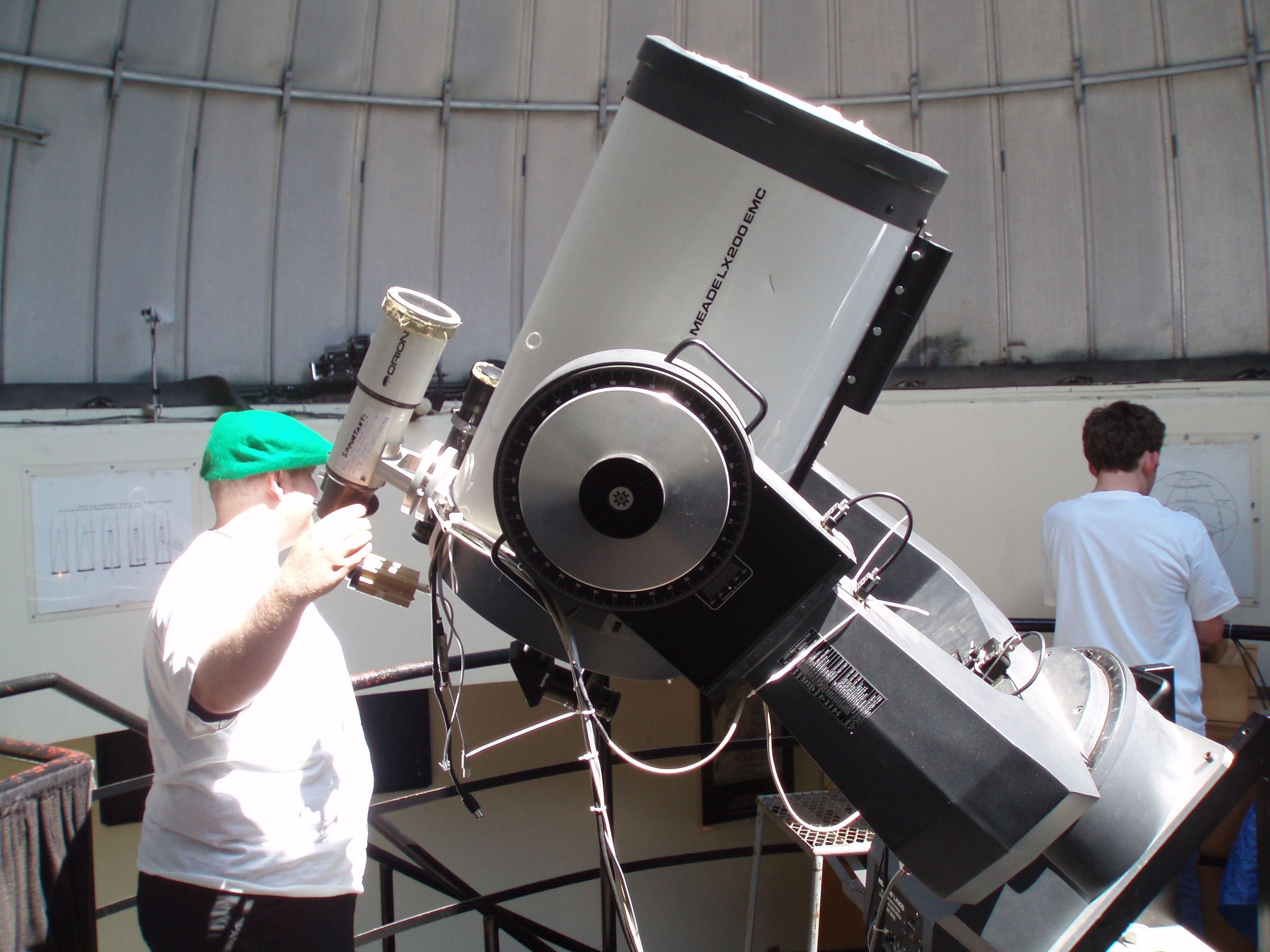|
Las Cumbres Observatory Global Telescope
Las Cumbres Observatory (LCO) is a network of astronomical observatories run by a non-profit private operating foundation directed by the technologist Wayne Rosing. Its offices are in Goleta, California. The telescopes are located at both northern and southern hemisphere sites distributed in longitude around the Earth. For some astronomical objects, the longitudinal spacing of telescopes allows continuous observations over 24 hours or longer. The operating network currently consists of two 2 meter telescopes, nine 1 meter telescopes, and seven 40 cm telescopes, placed at six astronomical observatories. The network operates as a single, integrated, observing facility, using a software scheduler that continuously optimizes the planned observing schedule of each individual telescope. History Rosing incorporated Las Cumbres Observatory in 1993 with the goal of aiding universities, observatories, and individuals in the acquisition and improvement of telescopes, op ... [...More Info...] [...Related Items...] OR: [Wikipedia] [Google] [Baidu] |
Cerro Tololo Interamerican Observatory
The Cerro Tololo Inter-American Observatory (CTIO) is an astronomical observatory located on Cerro Tololo in the Coquimbo Region of northern Chile, with additional facilities located on Cerro Pachón about to the southeast. It is approximately east of La Serena, where support facilities are located. The site was identified by a team of scientists from Chile and the United States in 1959, and it was selected in 1962. Construction began in 1963 and regular astronomical observations commenced in 1965. Construction of large buildings on Cerro Tololo ended with the completion of the Víctor Blanco Telescope in 1974, but smaller facilities have been built since then. Cerro Pachón is still under development, with two large telescopes (Gemini South and SOAR) inaugurated since 2000, and one in the early stages of construction (the Vera C. Rubin Observatory) The principal telescopes at CTIO are the 4 m Víctor M. Blanco Telescope, named after Puerto Rican astronomer Víctor Manue ... [...More Info...] [...Related Items...] OR: [Wikipedia] [Google] [Baidu] |
Sutherland, Northern Cape
Sutherland is a town with about 2,841 inhabitants in the Northern Cape province of South Africa. It lies in the western Roggeveld Mountains in the Karoo. History Sutherland was founded in 1855 as a church and market town to serve the area's sheep farmers. By 1872 the town had a population of 138 registered citizens living in 19 houses. The large Dutch Reformed church in the centre of Sutherland was built in 1899. During the Anglo Boer War the church was used as a fort by garrisoned British soldiers. During the war a number of engagements between British and Boer forces occurred in the town. In one such engagement a force of 250 Boer commandos attacked the local British garrison for 10 hours. The ruins of a fort can be found on the outskirts of town on the hill called Rebelskop. This was named after this engagement. Economy Major economic activities include tourism and sheep farming. The area includes at least twelve registered B&B's, guest houses and guest farms. The ... [...More Info...] [...Related Items...] OR: [Wikipedia] [Google] [Baidu] |
Gravitational Wave
Gravitational waves are waves of the intensity of gravity generated by the accelerated masses of an orbital binary system that propagate as waves outward from their source at the speed of light. They were first proposed by Oliver Heaviside in 1893 and then later by Henri Poincaré in 1905 as waves similar to electromagnetic waves but the gravitational equivalent. Gravitational waves were later predicted in 1916 by Albert Einstein on the basis of his general theory of relativity as ripples in spacetime. Later he refused to accept gravitational waves. Gravitational waves transport energy as gravitational radiation, a form of radiant energy similar to electromagnetic radiation. Newton's law of universal gravitation, part of classical mechanics, does not provide for their existence, since that law is predicated on the assumption that physical interactions propagate instantaneously (at infinite speed)showing one of the ways the methods of Newtonian physics are unable to explain ph ... [...More Info...] [...Related Items...] OR: [Wikipedia] [Google] [Baidu] |
Asteroids
An asteroid is a minor planet of the inner Solar System. Sizes and shapes of asteroids vary significantly, ranging from 1-meter rocks to a dwarf planet almost 1000 km in diameter; they are rocky, metallic or icy bodies with no atmosphere. Of the roughly one million known asteroids the greatest number are located between the orbits of Mars and Jupiter, approximately 2 to 4 AU from the Sun, in the main asteroid belt. Asteroids are generally classified to be of three types: C-type, M-type, and S-type. These were named after and are generally identified with carbonaceous, metallic, and silicaceous compositions, respectively. The size of asteroids varies greatly; the largest, Ceres, is almost across and qualifies as a dwarf planet. The total mass of all the asteroids combined is only 3% that of Earth's Moon. The majority of main belt asteroids follow slightly elliptical, stable orbits, revolving in the same direction as the Earth and taking from three to six years to comple ... [...More Info...] [...Related Items...] OR: [Wikipedia] [Google] [Baidu] |
Exoplanets
An exoplanet or extrasolar planet is a planet outside the Solar System. The first possible evidence of an exoplanet was noted in 1917 but was not recognized as such. The first confirmation of detection occurred in 1992. A different planet, initially detected in 1988, was confirmed in 2003. There are many methods of detecting exoplanets. Transit photometry and Doppler spectroscopy have found the most, but these methods suffer from a clear observational bias favoring the detection of planets near the star; thus, 85% of the exoplanets detected are inside the tidal locking zone. In several cases, multiple planets have been observed around a star. About 1 in 5 Sun-like starsFor the purpose of this 1 in 5 statistic, "Sun-like" means G-type star. Data for Sun-like stars was not available so this statistic is an extrapolation from data about K-type stars. have an "Earth-sized"For the purpose of this 1 in 5 statistic, Earth-sized means 1–2 Earth radii. planet in the habitable zone. ... [...More Info...] [...Related Items...] OR: [Wikipedia] [Google] [Baidu] |
Supernovae
A supernova is a powerful and luminous explosion of a star. It has the plural form supernovae or supernovas, and is abbreviated SN or SNe. This transient astronomical event occurs during the last evolutionary stages of a massive star or when a white dwarf is triggered into runaway nuclear fusion. The original object, called the ''progenitor'', either collapses to a neutron star or black hole, or is completely destroyed. The peak optical luminosity of a supernova can be comparable to that of an entire galaxy before fading over several weeks or months. Supernovae are more energetic than novae. In Latin, ''nova'' means "new", referring astronomically to what appears to be a temporary new bright star. Adding the prefix "super-" distinguishes supernovae from ordinary novae, which are far less luminous. The word ''supernova'' was coined by Walter Baade and Fritz Zwicky in 1929. The last supernova to be directly observed in the Milky Way was Kepler's Supernova in 1604, appearing not ... [...More Info...] [...Related Items...] OR: [Wikipedia] [Google] [Baidu] |
Meade Instruments
The Meade Instruments (also shortened to Meade) is an American multinational company headquartered in Watsonville, California, that manufactures, imports, and distributes telescopes, binoculars, spotting scopes, microscopes, CCD cameras, and telescope accessories for the consumer market. It is the world's largest manufacturer of telescopes. Besides selling under its "Meade" brand name, the company sells solar telescopes under the brand "Coronado". Origins and history Founded in 1972 by John Diebel, Meade started as a mail order seller of small refracting telescopes and telescope accessories manufactured by the Japan-based Towa Optical Manufacturing Company. Meade started manufacturing its own line of products in 1976, introducing 6" and 8" reflecting telescopes models in 1977. In 1980, the company ventured into the Schmidt-Cassegrain market that up to that time had been dominated by Celestron Corporation. Meade has a long history of litigation with other companies over infri ... [...More Info...] [...Related Items...] OR: [Wikipedia] [Google] [Baidu] |
LCOGT 40cm
Las Cumbres Observatory (LCO) is a network of astronomical observatories run by a non-profit private operating foundation directed by the technologist Wayne Rosing. Its offices are in Goleta, California. The telescopes are located at both northern and southern hemisphere sites distributed in longitude around the Earth. For some astronomical objects, the longitudinal spacing of telescopes allows continuous observations over 24 hours or longer. The operating network currently consists of two 2 meter telescopes, nine 1 meter telescopes, and seven 40 cm telescopes, placed at six astronomical observatories. The network operates as a single, integrated, observing facility, using a software scheduler that continuously optimizes the planned observing schedule of each individual telescope. History Rosing incorporated Las Cumbres Observatory in 1993 with the goal of aiding universities, observatories, and individuals in the acquisition and improvement of telescopes, opti ... [...More Info...] [...Related Items...] OR: [Wikipedia] [Google] [Baidu] |
LCOGT 1m
Las Cumbres Observatory (LCO) is a network of astronomical observatories run by a non-profit private operating foundation directed by the technologist Wayne Rosing. Its offices are in Goleta, California. The telescopes are located at both northern and southern hemisphere sites distributed in longitude around the Earth. For some astronomical objects, the longitudinal spacing of telescopes allows continuous observations over 24 hours or longer. The operating network currently consists of two 2 meter telescopes, nine 1 meter telescopes, and seven 40 cm telescopes, placed at six astronomical observatories. The network operates as a single, integrated, observing facility, using a software scheduler that continuously optimizes the planned observing schedule of each individual telescope. History Rosing incorporated Las Cumbres Observatory in 1993 with the goal of aiding universities, observatories, and individuals in the acquisition and improvement of telescopes, opti ... [...More Info...] [...Related Items...] OR: [Wikipedia] [Google] [Baidu] |
LCOGT 2m
Las Cumbres Observatory (LCO) is a network of astronomical observatories run by a non-profit private operating foundation directed by the technologist Wayne Rosing. Its offices are in Goleta, California. The telescopes are located at both northern and southern hemisphere sites distributed in longitude around the Earth. For some astronomical objects, the longitudinal spacing of telescopes allows continuous observations over 24 hours or longer. The operating network currently consists of two 2 meter telescopes, nine 1 meter telescopes, and seven 40 cm telescopes, placed at six astronomical observatories. The network operates as a single, integrated, observing facility, using a software scheduler that continuously optimizes the planned observing schedule of each individual telescope. History Rosing incorporated Las Cumbres Observatory in 1993 with the goal of aiding universities, observatories, and individuals in the acquisition and improvement of telescopes, opti ... [...More Info...] [...Related Items...] OR: [Wikipedia] [Google] [Baidu] |
Ngari Prefecture
Ngari Prefecture () or Ali Prefecture () is a prefecture of China's Tibet Autonomous Region covering Western Tibet, whose traditional name is Ngari Khorsum. Its administrative centre and largest settlement is the town of Shiquanhe. History Ngari was once the heart of the ancient kingdom of Guge. Later Ngari, along with Ü and Tsang, composed Ü-Tsang, one of the traditional provinces of Tibet, the others being Amdo and Kham. The lowlands of Ngari is known as Maryul. During the 10th century, the kingdom of Maryul was founded, taking the name Ladakh, lasted until 1842. The prefecture has close cultural links with Kinnaur and Lahaul and Spiti district of the bordering Indian state of Himachal Pradesh. Geography and climate The paved Xinjiang-Tibet Highway () passes through this area. There are well-known prehistoric petroglyphs near the far western town of Rutog. The town of Ngari lies above sea level in northwest Tibet some west of the capital, Lhasa. Ngari Gunsa Airpor ... [...More Info...] [...Related Items...] OR: [Wikipedia] [Google] [Baidu] |






